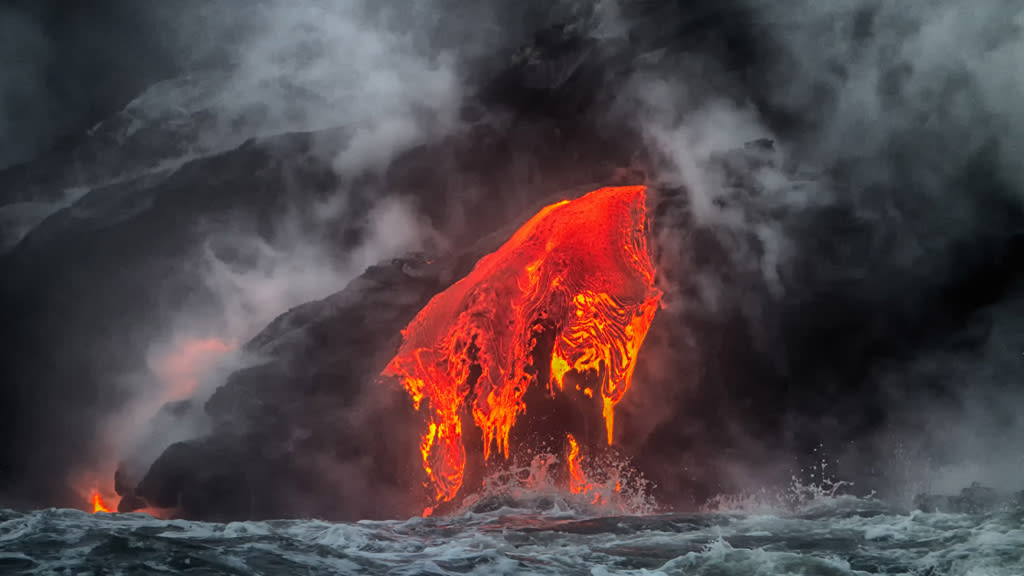The Ocean's Hidden Alchemy: Unseen Forces Make Waters Dance
Unveiling the Secrets of Subaqueous Volcanic Phenomena

The simultaneous eruption of all Earth's volcanoes would indeed be a cataclysmic event with far-reaching consequences for life on our planet. Here’s a breakdown of the potential impacts:
Immediate Effects
Explosions and Lava Flows: The immediate vicinity of each eruption would experience devastating explosions and lava flows. This would destroy infrastructure, habitats, and claim countless lives in the affected areas. The lava flows, moving at varying speeds, would incinerate everything in their path, including forests, cities, and farmland. These initial impacts would be catastrophic, but the real danger lies in the aftermath.
Atmospheric Impact
Ash Cloud: The eruptions would release vast quantities of ash into the atmosphere, blocking sunlight and creating a "volcanic winter." This prolonged period of darkness and reduced sunlight would severely disrupt photosynthesis, leading to crop failures and food shortages. The ash would blanket the globe, settling on land and water, and would take years to settle completely. This layer of ash could envelop the globe, blocking sunlight and plunging the world into a prolonged twilight.
Global Cooling: The reduction in sunlight would cause global temperatures to drop significantly. This cooling effect would have immediate impacts on climate, weather patterns, and ecosystems. Historically, even single volcanic eruptions like Mount Tambora in 1815 have caused "years without summer" due to the cooling effects of volcanic ash in the atmosphere. The simultaneous eruption of all volcanoes would magnify this effect, potentially causing temperatures to plummet worldwide.
Chemical Impact
Acid Rain: Volcanic gases like sulfur dioxide and hydrochloric acid would mix with the atmosphere, resulting in acid rain. This corrosive precipitation would poison groundwater and ocean surfaces, decimating marine life and coral reefs. The acid rain would damage crops, forests, and infrastructure, compounding the devastation caused by the initial eruptions. The delicate balance of our ecosystems would be thrown into chaos, reminiscent of past mass extinctions linked to major volcanic events.
Long-Term Environmental Impact
Volcanic Winter: The blanket of ash could linger in our atmosphere for up to a decade, creating a volcanic winter that would challenge the survival of many species, including humans. Without sunlight, photosynthesis would cease, crops would wither, and temperatures would plummet. The lack of sunlight and drop in temperatures would disrupt food chains and ecosystems around the globe. Many species would face extinction as their habitats and food sources are destroyed.
Global Warming Potential: Paradoxically, while the volcanic winter would initially cool the planet, the simultaneous eruption of all volcanoes would release enormous amounts of carbon dioxide. This greenhouse gas could eventually lead to a significant increase in global temperatures once the ash settles and sunlight returns. The combination of a volcanic winter followed by rapid global warming would create an inhospitable environment for most life forms. However, extremophiles, organisms that thrive in harsh conditions, might find a way to survive amidst the devastation.
Human Impact
Survival Challenges: For humans, survival would require drastic measures. We might need to seek refuge in underground bunkers or even construct space stations to escape the hostile surface conditions. The global food supply would be severely disrupted, leading to widespread famine. Water sources would be contaminated by ash and acid rain, making clean drinking water scarce. Societies would need to adapt to these harsh new realities, possibly leading to social upheaval and conflict over resources.
Technological and Medical Responses: Efforts to mitigate the impacts would include developing technologies to filter ash from the atmosphere, finding alternative food sources, and creating safe havens for humanity. Medical challenges would arise from respiratory issues due to inhaling ash, skin problems from acid rain, and mental health issues stemming from the prolonged crisis. Governments and international organizations would need to collaborate closely to manage the disaster and support affected populations.
Geological and Historical Context
Antarctic Volcanoes: Antarctica, often viewed as a frozen desert, hides a surprising number of volcanoes beneath its icy surface. Over 130 have been identified, with only Deception Island and Mount Erebus currently active. Erebus, continuously erupting since 1972, features a rare lava lake that remains molten due to a steady supply of magma. These Antarctic volcanoes add another layer of complexity to our understanding of global volcanic activity. Their simultaneous eruption would contribute to the overall devastation and further complicate the global response.
Supervolcanoes: Supervolcanoes, with their vast magma chambers, pose an even greater threat. Yellowstone is one of the most famous supervolcanoes, capable of unleashing eruptions that would spew vast amounts of ash and gases into the atmosphere, disrupting climates and ecosystems on a global scale. Although Yellowstone shows no signs of imminent eruption, its potential for destruction is a reminder of the powerful forces beneath our feet. The eruption of all supervolcanoes simultaneously would be particularly devastating, releasing unprecedented amounts of ash and gases.
Conclusion
While the simultaneous eruption of all volcanoes is an extremely unlikely event, understanding the potential impacts underscores the importance of monitoring and studying these natural phenomena. The story of Earth's volcanoes is one of immense power and profound consequences, shaping our planet in ways we are only beginning to comprehend. Enhanced monitoring and early warning systems are crucial for mitigating the impacts of future eruptions, ensuring that humanity is better prepared for the volatile nature of our planet.
About the Creator
Enjoyed the story? Support the Creator.
Subscribe for free to receive all their stories in your feed. You could also pledge your support or give them a one-off tip, letting them know you appreciate their work.





Comments
There are no comments for this story
Be the first to respond and start the conversation.